Topics List
Mar. 28, 2022 Updated
Registration is NOW OPEN for The Ryugu AO
|
Finally, the Ryugu AO system starts proposal registration! To join the program, please create your account by March 25th. 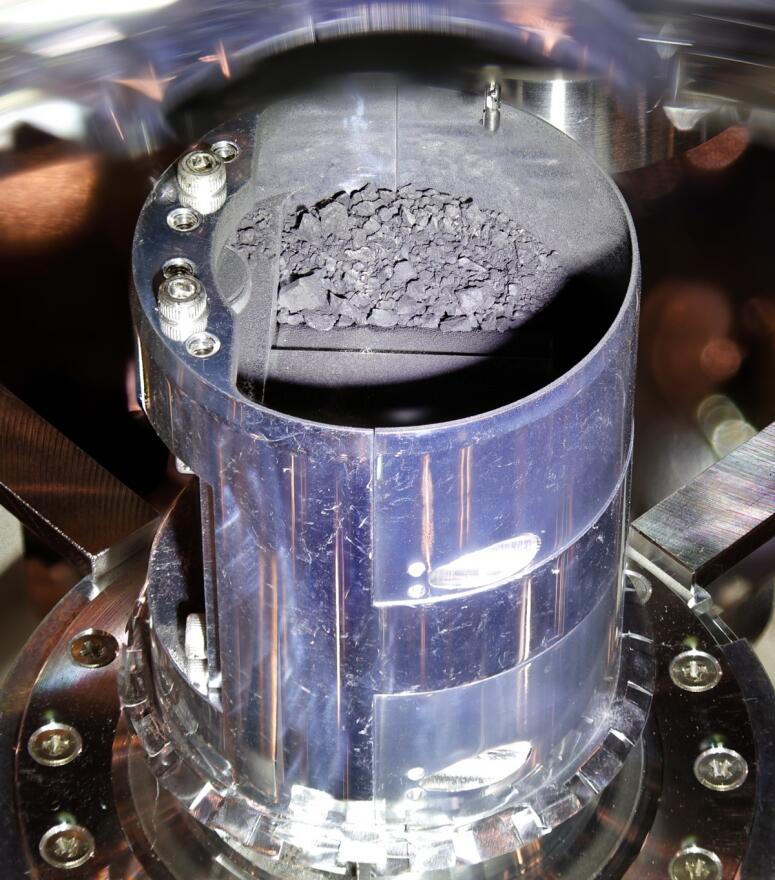
|
Feb. 14, 2022 Updated
Research published in “Science” asks how representative is the sample returned by Hayabusa2 of the entire asteroid?
|
The sample returned by Hayabusa2 from asteroid Ryugu is compared with observations of the asteroid from the Hayabusa2 spacecraft. The results of this analysis have been published in the US scientific journal, “Science” on February 10 (EST). 
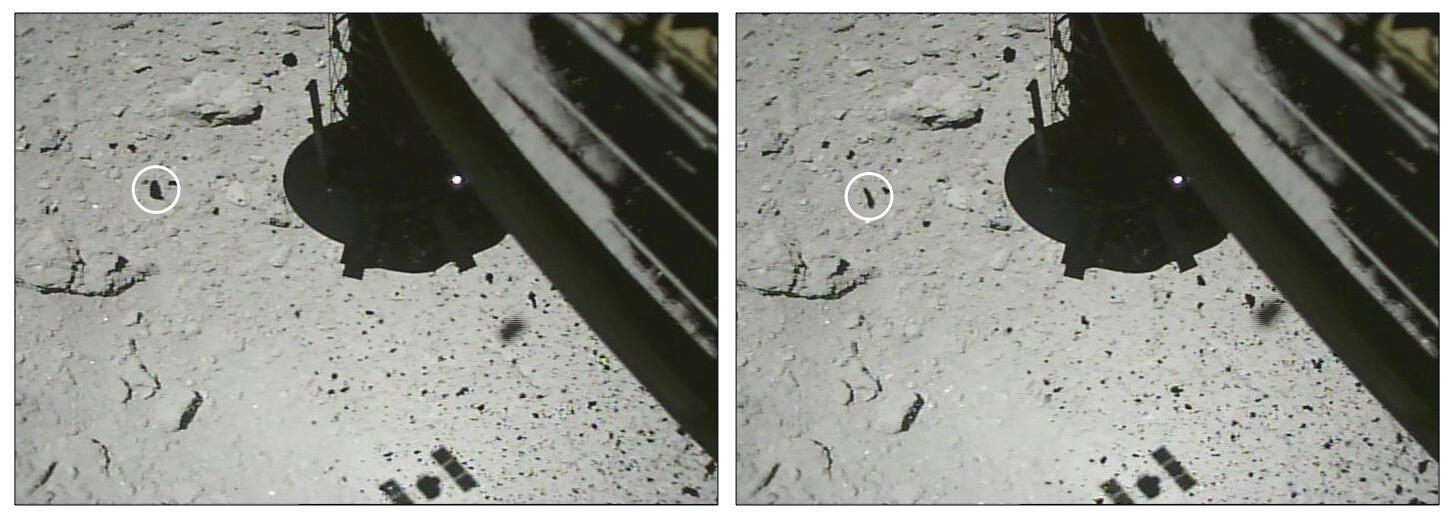
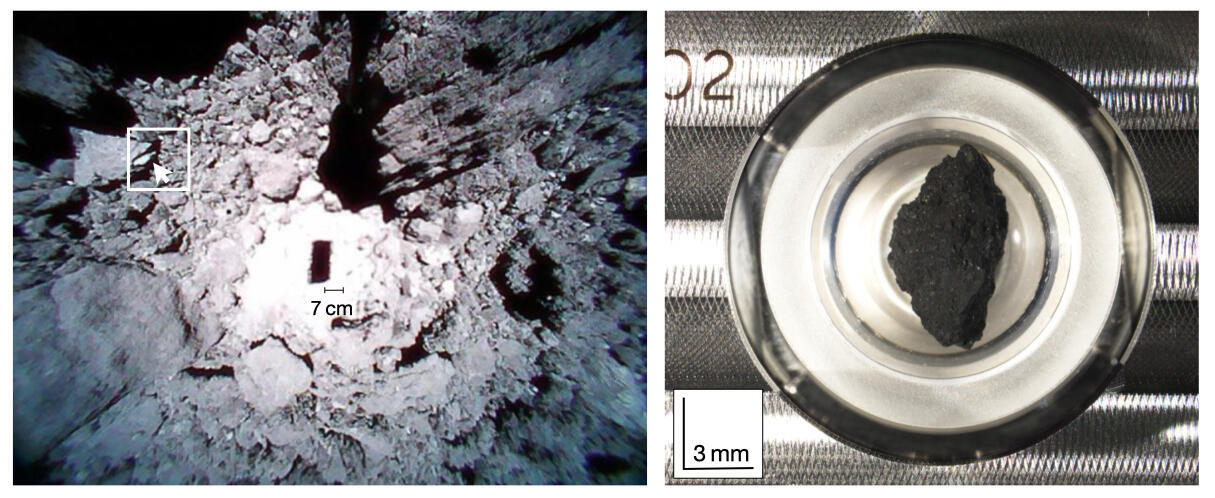
Click here for details: |
Dec. 21, 2021 Updated
Ryugu is a primitive asteroid rich in water and organic matter: A first look at the unprocessed carbonaceous asteroid sample returned by Hayabusa2, published in Nature Astronomy
|
The first results from the initial description of the sample from asteroid Ryugu returned by the Hayabusa2 spacecraft have been published in the British online journal, Nature Astronomy (December 21, 2021 JST). 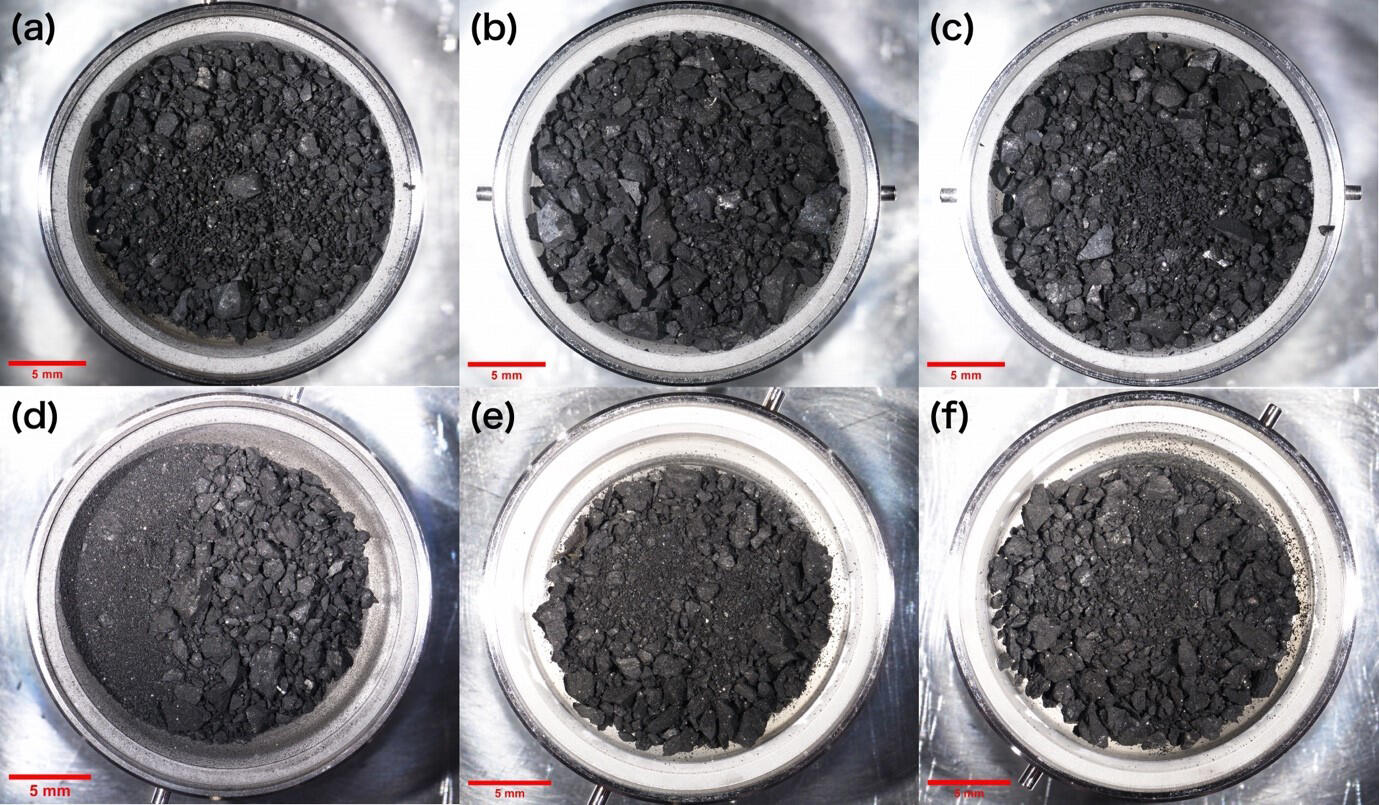
Click here for details: |
Dec. 7, 2020 Updated
Gas sampling from the Hayabusa2 sample container
|
This morning (December 7), the recovery team confirmed that the re-entry capsule was properly sealed and completed the gas sampling work. Although we analyzed the collected gas and evaluated the data, we have not yet determined whether it originates from the sample from Ryugu. A detailed analysis will continue in Japan. 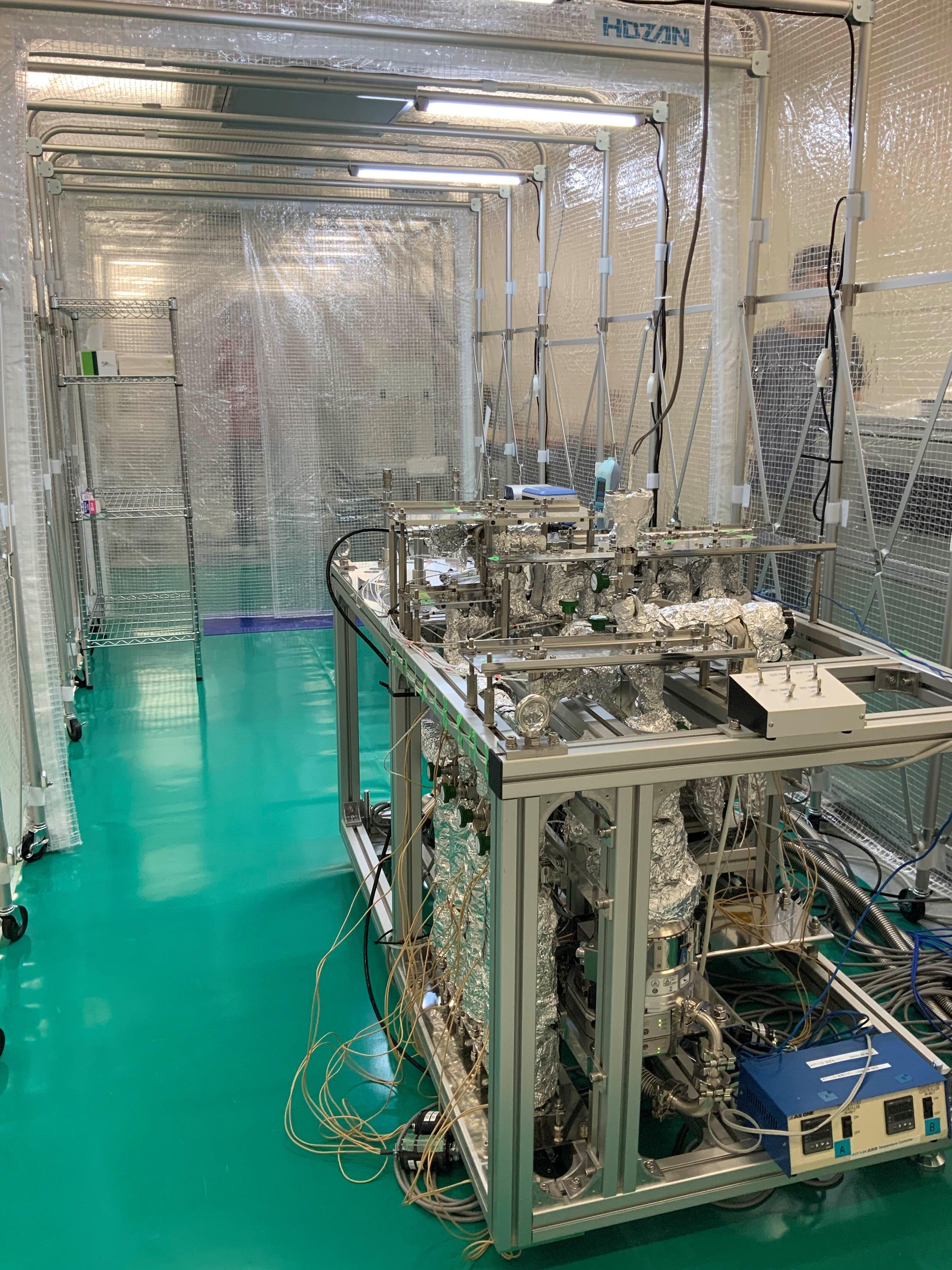
Equipment brought to Australia for gas analysis.
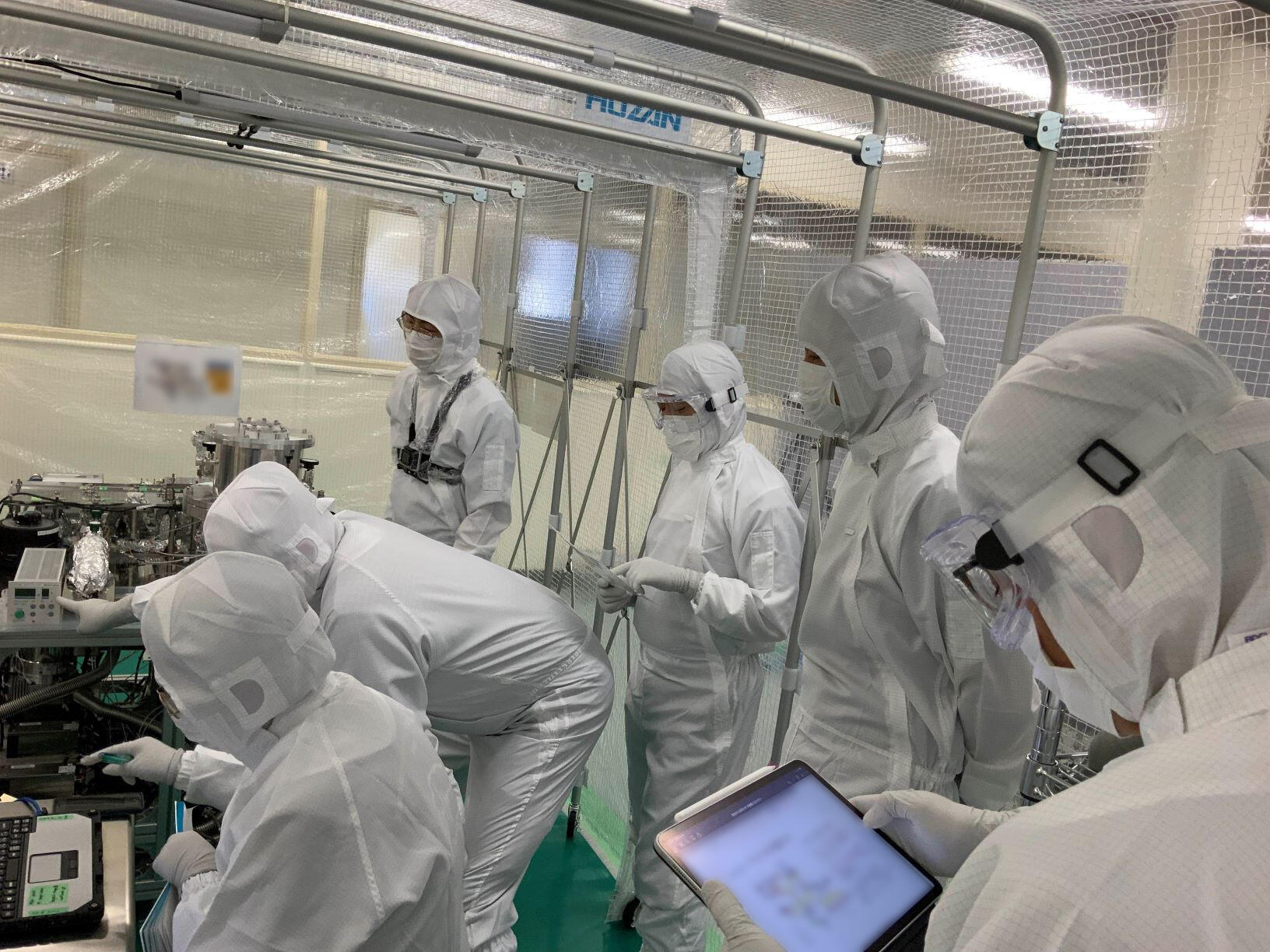
After the completion of the set-up of the clean booth, a test run is underway.
|
Dec. 6, 2020 Updated
Completion of Transportation of Hayabusa2 Re-entry Capsule to QLF
|
The helicopter carrying Hayabusa2 re-entry capsule arrived at the Quick Look Facility (QLF) at 8:03 December 6, 2020 (JST). 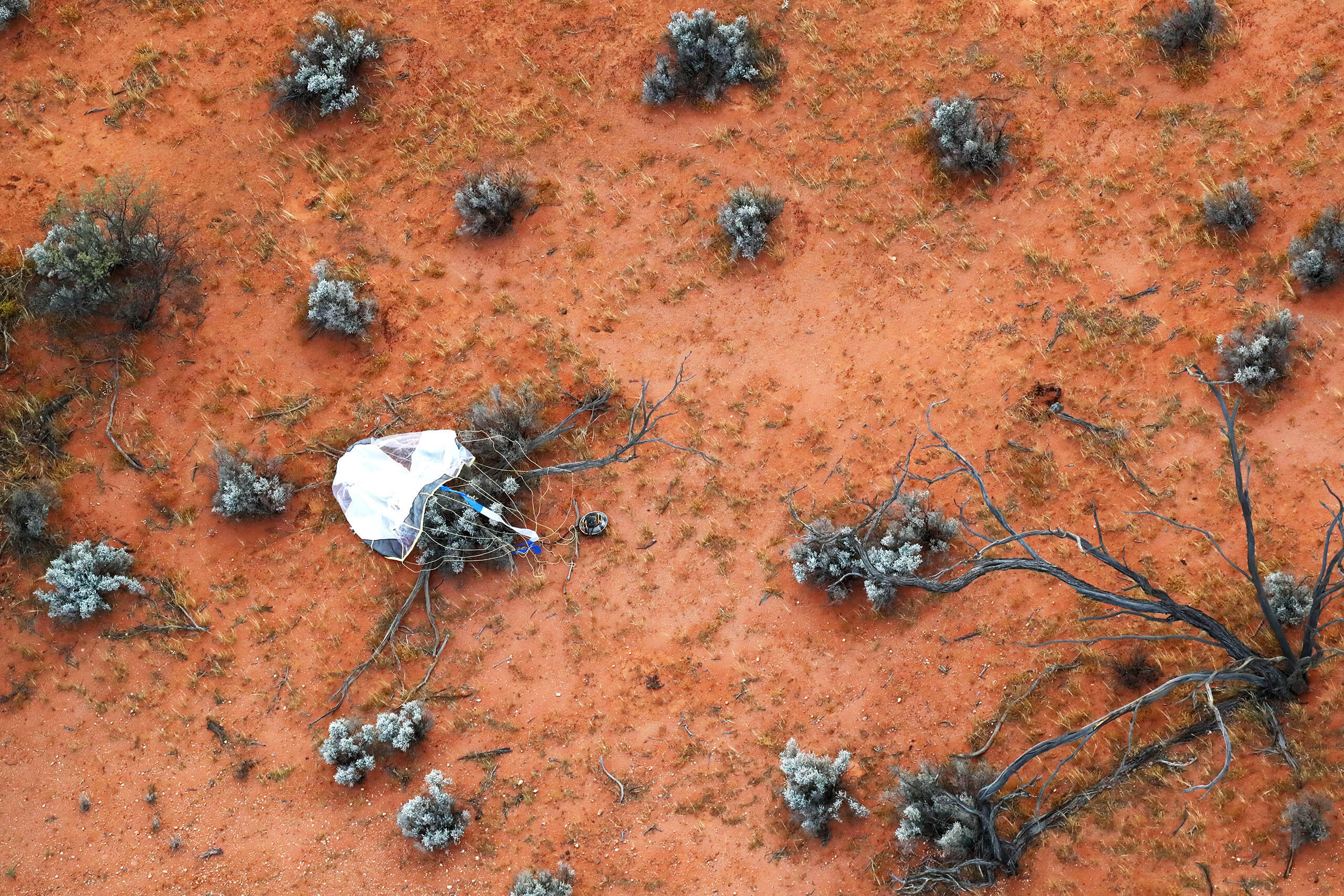
Re-entry capsule collection |
Dec. 6, 2020 Updated
Result of Hatabusa2 Re-entry Capsule Search
|
Hayabusa2 re-entry capsule re-entered the atmosphere at around 2:28 a.m. on December 6, 2020 (JST). The Japan Aerospace Exploration Agency (JAXA) searched for the capsule by helicopter and located its landing site in WPA, Australia at 4:47 December 6, 2020 (JST). 
Fireball taken from Coober Pedy 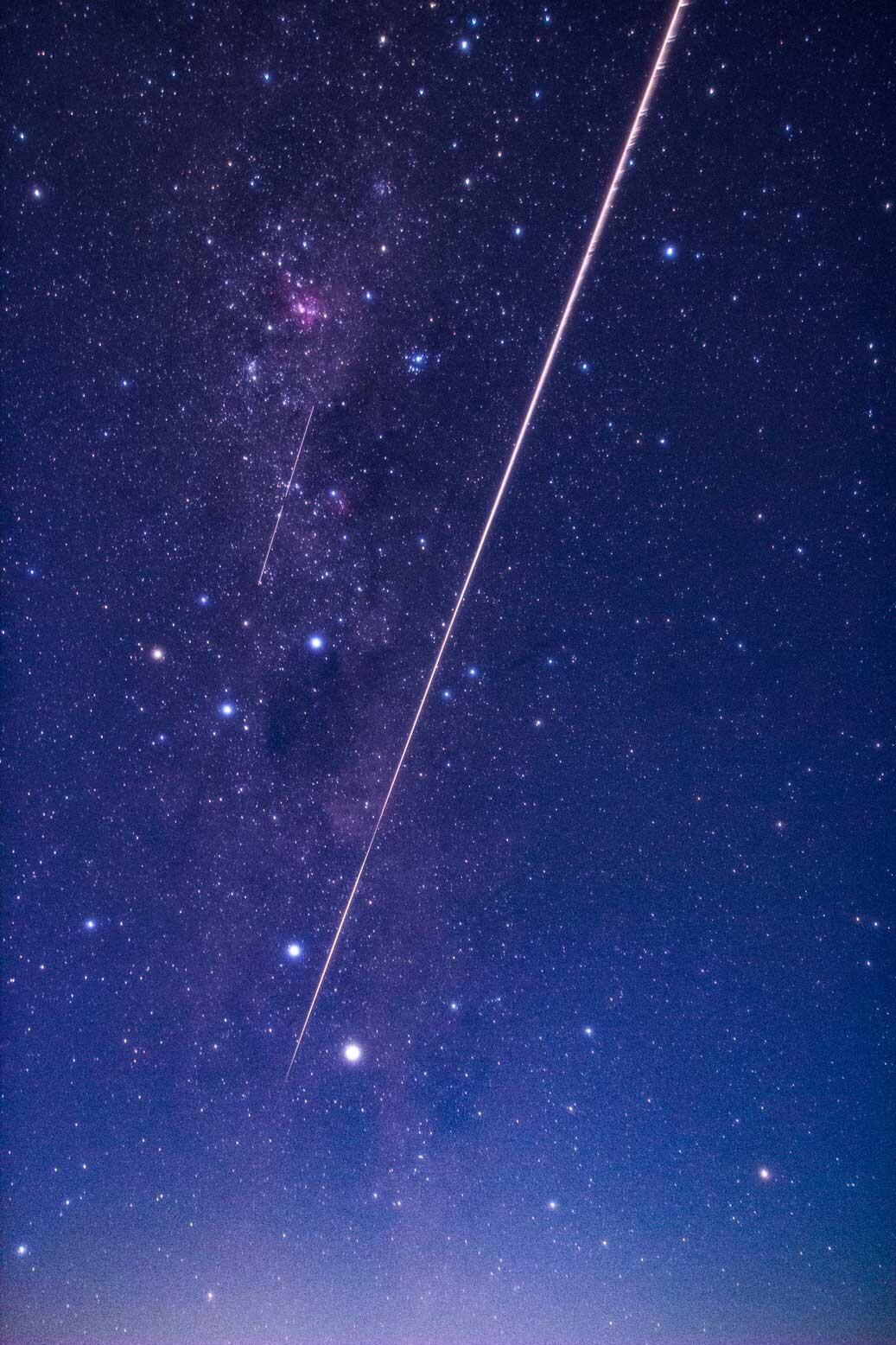
Fireball taken from Coober Pedy 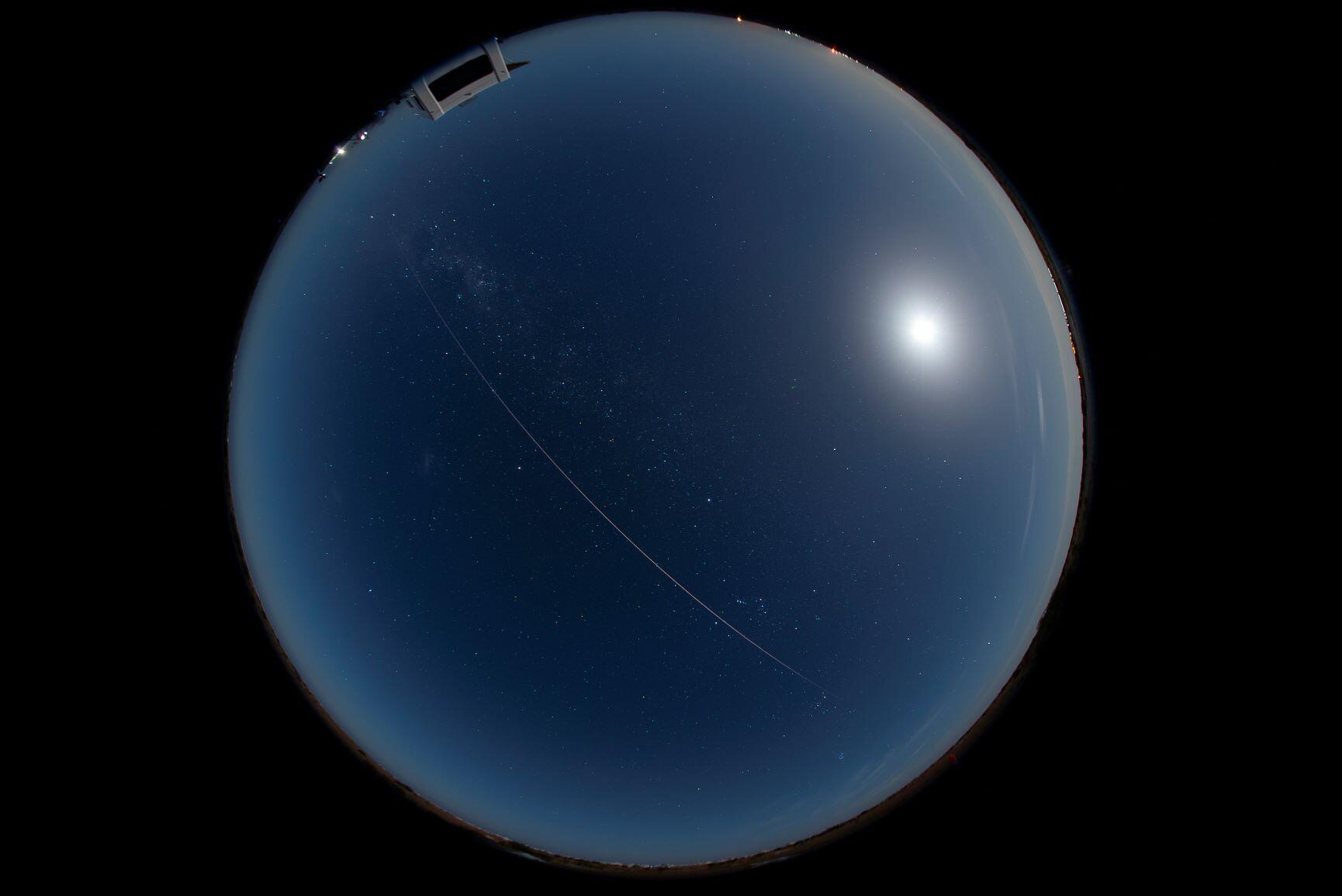
Fireball taken from Coober Pedy 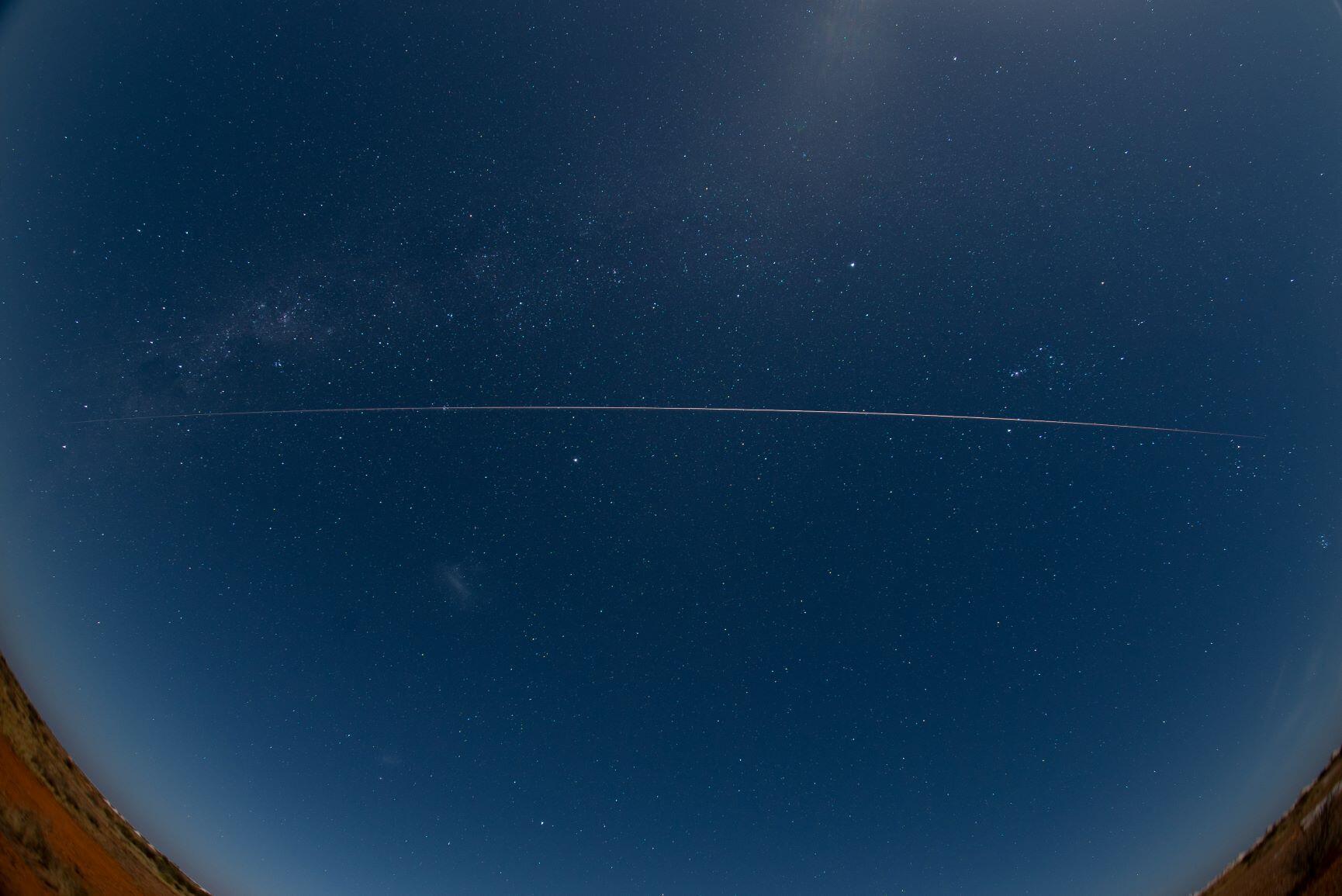
Fireball taken from Coober Pedy 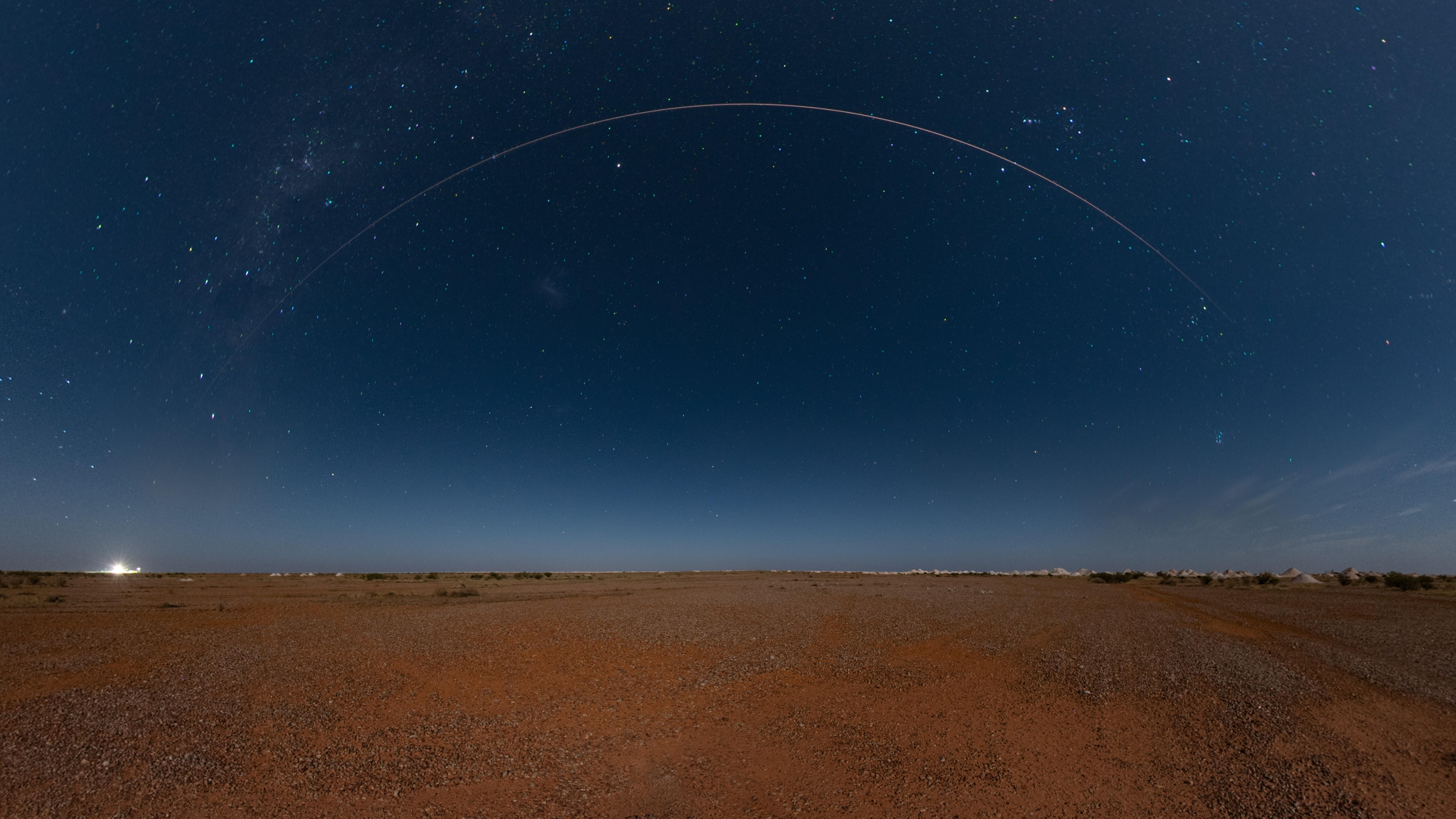
Fireball taken from Coober Pedy |
Dec. 5, 2020 Updated
Successful Separation of Hayabusa2 Re-entry Capsule
|
It was confirmed from telemetry and Doppler data that Hayabusa2 re-entry capsule separated from the Hayabusa2 spacecraft as planned at 14:35 on December 5, 2020 (JST). |
May 22, 2020 Updated
[HAYABUSA2 PROJECT] Messages from our members overseas
|
When the start of the second ion engine operation on May 12 was announced to Hayabusa2 project members overseas, they showered the local team with messages! As the current situation with the novel coronavirus is creating difficult times worldwide, we would like to share these encouraging replies that uplifted the team here in Japan. |
![[HAYABUSA2 PROJECT] Messages from our members overseas](https://global.jaxa.jp/projects/hayabusa2/images/topics_20200522_hayabusa2.jpg)
|
|---|
Jun. 27, 2019 Updated
JAXA and CNES Sign Implementing Arrangement on Martian Moons eXploration (MMX) and Hayabusa2
|
Japan Aerospace Exploration Agency has agreed to cooperate with Centre National d'Etudes Spatiales (CNES) on the study-phase activities in JAXA’s Martian Moons eXploration(MMX) mission and analysis of Hayabusa2-returned samples. 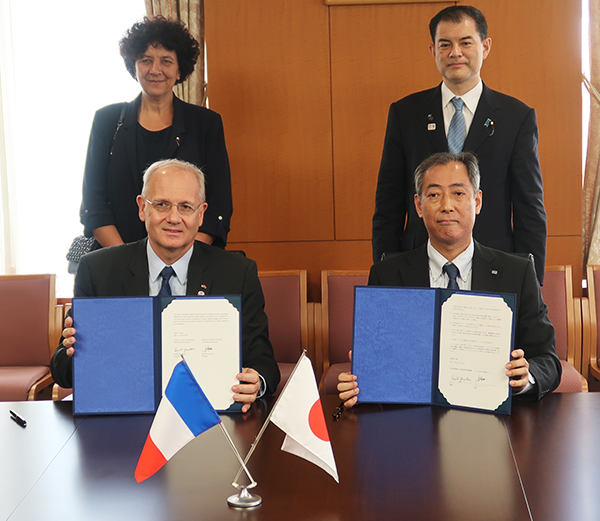
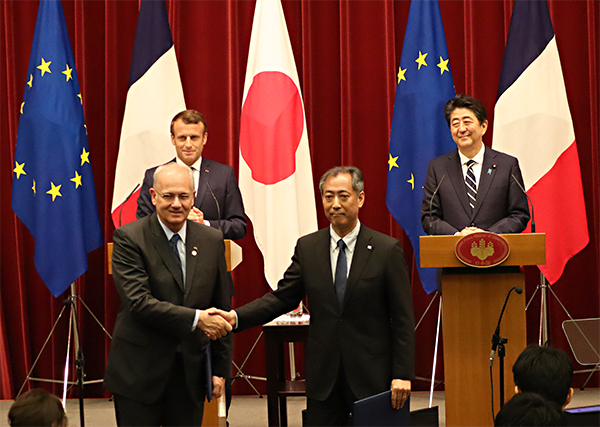
About the Implementing Arrangement concerning cooperative activities related to Martian Moon eXploration (MMX) mission studies
The MMX mission is planned to observe Mars’ two moons, Phobos and Deimos and to collect surface material from one of the moons to bring back to Earth. It aims to clarify the origin of the Martian moons and the process of evolution for Mars region and to improve technologies required for future exploration.
For more information on MMX, visit: About the Implementing Arrangement concerning cooperative activities related to analysis of Hayabusa2 return samples by MicrOmega at JAXA Extraterrestrial Sample Curation Center
Hayabusa2 is a successor of Hayabusa. By investigating the asteroid Ryugu(type-C asteroid)and collecting samples for return to Earth, it aims to clarify the origins and evolution of Earth as well as organic materials that formed the oceans and the life.
For more information on Hayabusa2, visit: |
Apr. 4, 2019 Updated
[HAYABUSA2 PROJECT] SCI (Small Carry-on Impactor) Operation Schedule
|
The Small Carry-on Impactor (SCI) operation will take place between April 3 – 6. This is an impact experiment to create an artificial crater in a designated area. |
![[HAYABUSA2 PROJECT] SCI (Small Carry-on Impactor) Operation Schedule](https://global.jaxa.jp/projects/hayabusa2/images/topics_20190403_sci_schedule_e.jpg)
|
|---|
Mar. 28, 2019 Updated
[HAYABUSA2 PROJECT] Revised illustrations of Hayabusa2
|
At the beginning of the Hayabusa2 Project, realistic illustrations were drawn by Akihiro Ikeshita. These illustrations have now been revised to match the actual asteroid Ryugu. |
![[HAYABUSA2 PROJECT] Revised illustrations of Hayabusa2](https://global.jaxa.jp/projects/hayabusa2/images/topics_20190328_illustration.jpg)
|
|---|
Mar. 20, 2019 Updated
[HAYABUSA2 PROJECT] The Crater Search Operation (Pre-SCI): CRA1
|
Currently, we have scheduled the small carry-on impactor operation (SCI operation) for the first week in April. The purpose of the SCI operation is to create a crater on the surface of Ryugu, and it is important to be able to compare the asteroid surface before and after the SCI operation. Before performing the SCI operation, we therefore decided to observe the area where the crater is likely to be generated. This is the “Crater Search Operation (Pre-SCI)" (CRA1). The same observational procedure will be performed after the SCI operation and denoted “Crater Search Operation (Post SCI)" (CRA2). |
![[HAYABUSA2 PROJECT] The Crater Search Operation (Pre-SCI): CRA1](https://global.jaxa.jp/projects/images/tn_topics_20190316_CRA1_e.jpg)
|
|---|
Feb. 25, 2019 Updated
[HAYABUSA2 PROJECT] Image from just after touchdown
|
From February 20 to 22, we conducted the touchdown operation (TD1-L8E1) of Hayabusa2 on the surface of asteroid Ryugu. Figure 1 shows an image taken with the Optical Navigation Camera – Wide angle (ONC-W1) during the spacecraft ascent after touchdown.
Figure 1: Image captured near the touchdown site immediately after touchdown. The photograph was taken with the Optical Navigation Camera – Wide angle (ONC-W1) on February 22, 2019 at an onboard time of around 07:30 JST. |
![[HAYABUSA2 PROJECT] Image from just after touchdown](https://global.jaxa.jp/projects/images/topics_20190225_td1_w1image_e.jpg)
|
|---|
Feb. 22, 2019 Updated
[HAYABUSA2 PROJECT] Thank you for your support!
|
The Hayabusa2 Project has received messages of support from so many people. The encouragement and enthusiasm from you all for the mission has made the entire project team fired up and enthusiastic! |
![[HAYABUSA2 PROJECT] Thank you for your support!](https://global.jaxa.jp/projects/images/topics_20190220_messages.jpg)
|
|---|
Feb. 21, 2019 Updated
[HAYABUSA2 PROJECT] The touchdown site
|
Up until now, the Hayabusa2 mission has progressed smoothly. One particular success was the landing of the small rovers on the surface of Ryugu, which could not be achieved during the first Hayabusa mission. Now on February 22, 2019, we plan to touchdown on the asteroid surface; another challenge that did not go as expected for Hayabusa. |
![[HAYABUSA2 PROJECT] The touchdown site](https://global.jaxa.jp/projects/images/topics_20190220_tdpoint.jpg)
|
|---|
Feb. 18, 2019 Updated
[HAYABUSA2 PROJECT] Shooting bullets into Ryugu!
|
On December 28 —the last day of work in 2018— the sampler team conducted an important experiment. As a final test before touchdown (TD), the team fired an identical bullet to that onboard Hayabusa2 into a simulated soil of the surface of Ryugu to test how much sample would be ejected. |
![[HAYABUSA2 PROJECT] Shooting bullets into Ryugu!](https://global.jaxa.jp/projects/images/topics_20190214_Experiment_e.jpg)
|
|---|
Feb. 4, 2019 Updated
[HAYABUSA2 PROJECT] Correction to the name of the MINERVA-II1 landing site.
|
The landing site for the small exploration rovers, MINERVA-II1, was announced on December 13, 2018 as “Trinitas”, but this will be corrected to “Tritonis”. |
![[HAYABUSA2 PROJECT] Correction to the name of the MINERVA-II1 landing site.](https://global.jaxa.jp/projects/images/topics_20190201_Nomenclature_e.jpg)
|
|---|
Jan. 21, 2019 Updated
[HAYABUSA2 PROJECT] Locations on the surface of Ryugu have been named!
|
Place names for locations on the surface of Ryugu were discussed by Division F (Planetary Systems and Bioastronomy) of the International Astronomical Union (IAU) Working Group for Planetary System Nomenclature and approved in December 2018. We will introduce the place names and the background to their selection. |
![[HAYABUSA2 PROJECT] Locations on the surface of Ryugu have been named!](https://global.jaxa.jp/projects/images/topics_20190121_Nomenclature_e.jpg)
|
|---|
Jan. 16, 2019 Updated
[HAYABUSA2 PROJECT] Mission Manager Yoshikawa selected for "Nature's 10" in 2018
|
Our Mission Manager, Makoto Yoshikawa, has been chosen by the science journal, Nature, as one of the "ten people who mattered in science this year" in "The 2018 Nature's 10". |
![[HAYABUSA2 PROJECT] Mission Manager Yoshikawa selected for "Nature's 10" in 2018](https://global.jaxa.jp/projects/images/topics_20190116_Nature_e.jpg)
|
|---|
Dec. 25, 2018 Updated
[HAYABUSA2 PROJECT] Astrodynamics and the Gravity Measurement Descent Operation
|
Until now, "astrodynamics" has been one of the less frequently reported operations for Hayabusa2. In space engineering, the movement, attitude, trajectory and overall handling of the flight mechanics of the spacecraft is referred to as "astrodynamics". For example, astrodynamics played an active role in the gravity measurement descent operation in August 2018. While this was a short time ago, let's look at a few of the details. |
![[HAYABUSA2 PROJECT] Astrodynamics and the Gravity Measurement Descent Operation](https://global.jaxa.jp/projects/images/topics_20181225_AstroDynamics_e.jpg)
|
|---|
Dec. 25, 2018 Updated
[HAYABUSA2 PROJECT] Spacecraft orbit during solar conjunction
|
From late November 2018 until the end of December, the solar conjunction operation is underway for Hayabusa2. Solar conjunction refers to the situation where the direction to the spacecraft almost overlaps with that to the Sun when viewed from the Earth. This is the same "conjunction" as in astronomy, whereby planets and stars appear to line up on the sky. During this time, communication with Hayabusa2 is disrupted due to radio waves emitted from the Sun and from its surrounding plasma. We therefore do not perform operations such as descending towards Ryugu during this period. |
![[HAYABUSA2 PROJECT] Spacecraft orbit during solar conjunction](https://global.jaxa.jp/projects/images/topics_20181225_Conjunction_e.jpg)
|
|---|
Dec. 13, 2018 Updated
[HAYABUSA2 PROJECT] Naming our MINERVA-II1 rovers
|
On September 21, 2018 (JST), the two MINERVA-II1 rovers (Rover-1A and Rover-1B) separated from the Hayabusa2 spacecraft to land on the surface of asteroid Ryugu, where they successfully imaged and hopped across the asteroid surface autonomously. These two rovers have now been given names.
|
![[HAYABUSA2 PROJECT] Naming our MINERVA-II1 rovers](https://global.jaxa.jp/projects/images/topics_20181213_MNRV-II1_e.jpg)
|
|---|
Oct. 30, 2018 Updated
[HAYABUSA2 PROJECT] Small Monitor Camera captures ‘cool’ images!
|
During the operation for Touchdown 1 Rehearsal 3 (TD1-R3), we attempted to capture images using CAM-H (small monitor camera) as the spacecraft approached the surface of Ryugu. CAM-H was manufactured and installed on Hayabusa2 by donations received from the general public and it is attached near the lower edge of the side of the spacecraft. The camera can photograph the tip of the sampler horn, but it can also capture the surrounding area and background. |
![[HAYABUSA2 PROJECT] Small Monitor Camera captures ‘cool’ images!](https://global.jaxa.jp/projects/images/topics_20181030_TD1R3_CAMH_e.jpg)
|
|---|
Oct. 26, 2018 Updated
[HAYABUSA2 PROJECT] The highest resolution image of Ryugu (resolution update : the highest resolution image to date)
|
The second touchdown rehearsal (TD1-R1-A) was performed from October 14 to 16. On October 15, just before 22:44 JST when the spacecraft reached a new low altitude of 22.3m, we successfully photographed the surface of Ryugu using the Optical Navigation Camera – Telescopic (ONC-T). This is the highest resolution image to date (Figure).
|
![[HAYABUSA2 PROJECT] The highest resolution image of Ryugu (resolution update : the highest resolution image to date)](https://global.jaxa.jp/projects/images/topics_20181025_hayabusa2_e.jpg)
|
|---|
Jul. 25, 2018 Updated
Imaging Ryugu from an altitude of 6km
|
Hayabusa2 arrived at asteroid Ryugu on June 27, after which the spacecraft remained at a distance of about 20km (the Home Position) to continue to observe the asteroid. During this time, the spacecraft was maintaining a hovering altitude of 20km above the asteroid surface. Figure 1: ※Please use the displayed credit when reproducing these images. In the case where an abbreviated form is necessary, please write "JAXA, University of Tokyo & collaborators". |
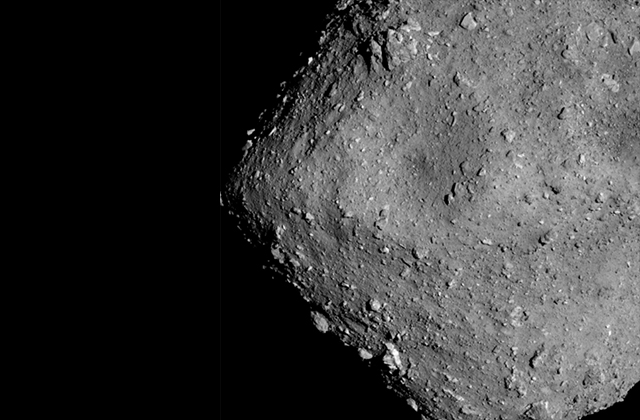
|
|---|
Jul. 17, 2018 Updated
Bremen Town Hall Exhibits Hayabusa2 and Mascot, July 10 to October 14
|
The Bremen City Hall, Bremen, Germany houses on exhibit the JAXA asteroid explorer Hayabusa2, and MASCOT, the onboard lander MASCOT, developed by DLR (Deutsches Zentrum für Luft- und Raumfahrt, English: The German Aerospace Center) and CNES (The Centre National d’Etudes Spatiales, English: French National Centre for Space Studies). The City Hall, UNESCO World Heritage Site accommodates the exhibits July 10 through October 14. At 9:35 am Japan Time, June 27, Hayabusa2 rendezvoused with Ryugu, the target asteroid. Keeping its 20-kilometer distance away from the asteroid, or its home position, Hayabusa2 is being confirmed of its function that performs future operations. MASCOT will land on the asteroid around October this year for observations of the surface using four instruments. 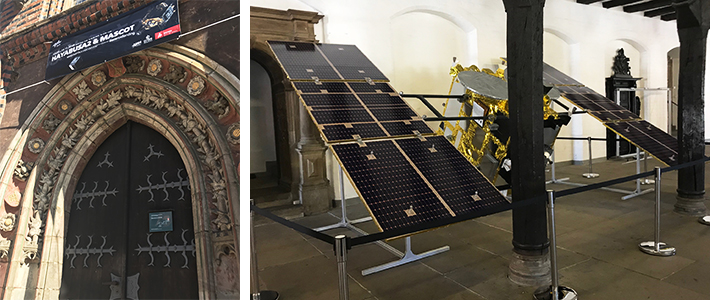
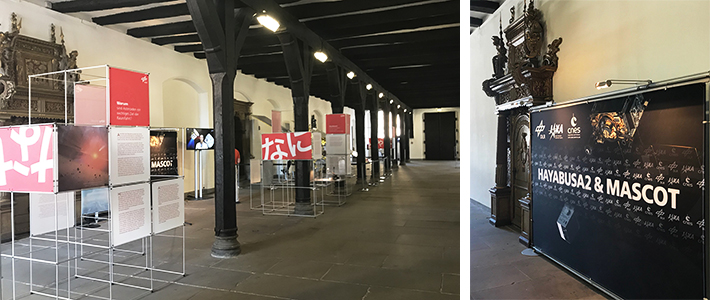
|
Jul. 4, 2018 Updated
Stereo image of asteroid Ryugu by Dr. Brian May
|
Brian May, the lead guitarist from the British rock band, Queen, has created a stereoscopic image of Ryugu from photographs captured with the ONC-T camera onboard Hayabusa2, so that the asteroid can be viewed in three dimensions. Brian May is an astronomer, with a doctoral degree in astrophysics from Imperial College London. He has a strong interest in planetary defense or space guard, which considers the potential threat to the Earth from meteorites. As part of this, May is a core member of "Asteroid Day", that began about three years ago to increase awareness of asteroids and action that can be taken to protect the Earth. |
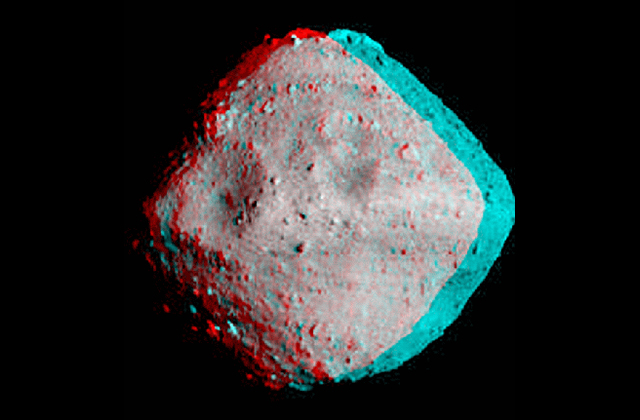
|
|---|
Jun. 29, 2018 Updated
Arrival at Ryugu!
|
1302 days after the launch from Tanegashima Space Center on December 3, 2014, 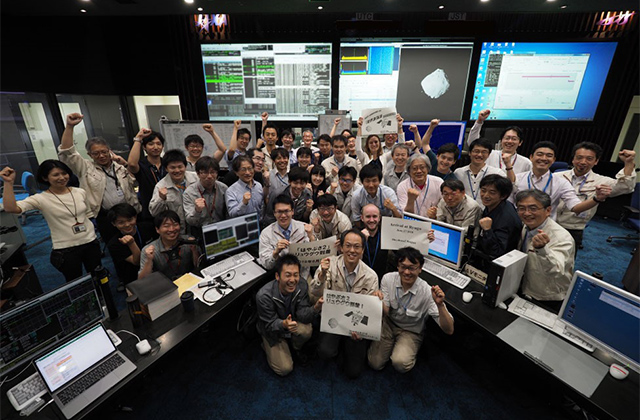
Figure: Group photo commemorating arrival at Ryugu. This is our triumphant pose (known as the "guts pose" / ガッツポーズ in Japanese). |
Jun. 25, 2018 Updated
Asteroid Ryugu seen from a distance of around 40km
|
Hayabusa2 is close to arriving at asteroid Ryugu. After a journey of around 3.2 billion km since launch, our destination is finally near. Two small objects will soon meet in outer space 280 million km from the Earth. |
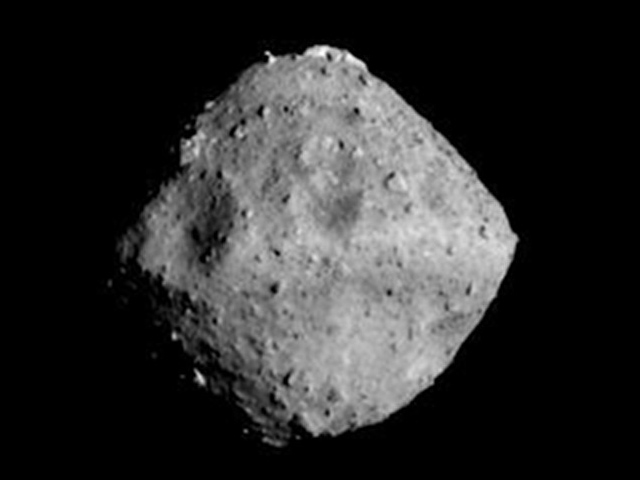
|
|---|
Jun. 19, 2018 Updated
Ryugu seen from 330-240km
|
The ONC-T (Optical Navigation Camera - Telescopic) captured images of Ryugu on June 17, 2018 at around 15:00 JST and June 18 at around 06:00 JST. At 15:00 JST on June 17, the distance to Ryugu was approximately 330 km, which had decreased to 240 km by June 18 at 06:00 JST. |
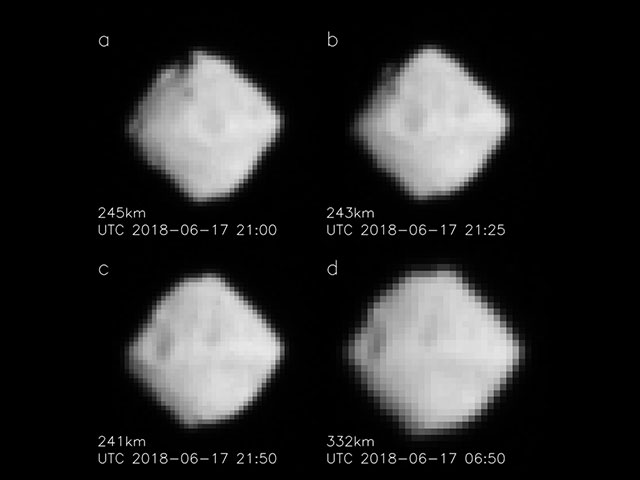
|
|---|
Jun. 16, 2018 Updated
From a distance of about 700km, Ryugu's rotation was observed.
|
Using the ONC-T (Optical Navigation Camera - Telescopic), asteroid Ryugu was photographed continuously from June 14, 2018 at around 21:00 JST through to June 15, 2018 at around 05:10 JST. Figure 1 shows a looped animation of the 52 captured images. |
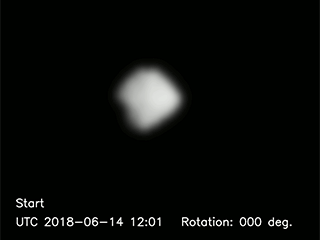
|
|---|
Jun. 14, 2018 Updated
Ryugu seen from a distance of 920km
|
Hayabusa2 is steadily approaching asteroid Ryugu. Figure 1 shows a photograph of Ryugu taken on June 13, 2018 with the ONC-T (Optical Navigation Camera-Telescopic) from a distance of about 920km. The celestial body shining brightly in the center of the frame is Ryugu. The movement of Ryugu (in comparison to the background stars) can be seen by comparing this image with those taken on June 6 and June 10. The brightness of Ryugu is now about -6.6 mag (astronomical magnitude: a logarithmic scale for the apparent brightness for an object). |

|
|---|
Jun. 7, 2018 Updated
Ryugu seen from a distance of 2600km
|
On June 3, 2018, ion engine operation was completed and the final approach to the asteroid begun. By photographing the asteroid with the Optical Navigation Camera, optical navigation (precisely “hybrid navigation using optical and radiometric observations”) can be used to approach Ryugu while accurately estimating the trajectory of the spacecraft and asteroid. |
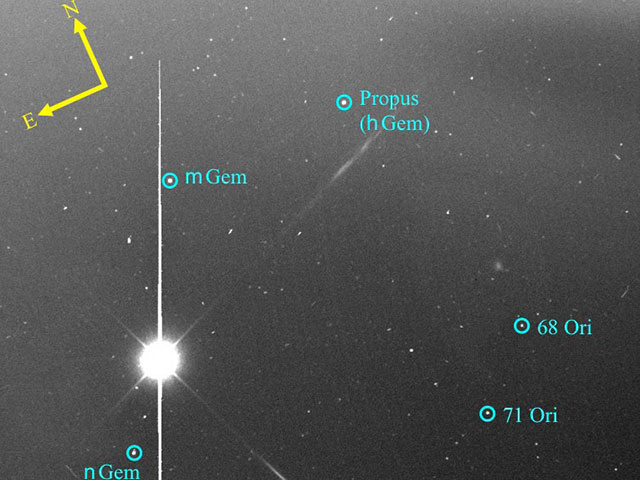
|
|---|
Jul. 1, 2016 Updated
Ryugu Observation Campaign (for expert observers)
|
The target asteroid of Hayabusa2 is (162173) Ryugu, 1999 JU3 in the provisional designation. Hayabusa2 will arrive at this asteroid in June - July 2018. In this summer, we have a opportunity to observe Ryugu, so we set up "Ryugu Observation Campaign" from July 1 to August 15, 2016. This is the last chance to observe Ryugu before Hayabusa2 arrives there. However the maximum apparent magnitude will be just 18th mag, so it is rather dark. Maybe you need a telescope with the diameter of 1m or so. Or you must follow the motion of Ryugu with your telescope. Therefor the observation will be rather difficult, but please try it if you can. Good luck! |
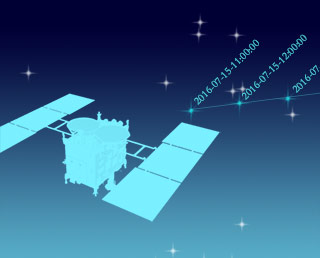
|
|---|
Mar. 31, 2016 Updated
Hayabysa2 mission logo color change
|
It has been a year since Hayabusa2 was launched, and we changed the color of the mission logo while moving to the Transfer orbit* phase. |
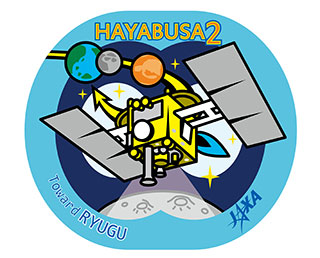
|
|---|
Dec. 25, 2015 Updated
The Optical Link Experiment with the Laser Altimeter (LIDAR)
|
Before and after the Earth swing-by, the laser altimeter (LIDAR) on Hayabusa2 attempted to receive laser light from the satellite laser ranging (SLR) ground stations. |
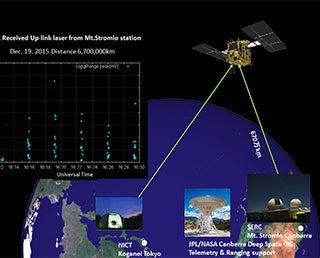
|
|---|
Dec. 24, 2015 Updated
Photographing the Earth just before Hayabusa2's swing-by : Complete version
|
In our previous post, we shared images of the Earth taken by Hayabusa2, as the spacecraft approached for the Earth swing-by. There, we showed the Earth from 09:00 JST (00:00 UT) through to 17:45 JST (08:45 UT). In this post, we extend the animation to show all the images that were taken of the Earth from the ONC-W2 camera during the Earth approach which runs to 18:30 JST (09:00 UT) (Figure 1). Figure 2 shows the images individually that comprise the animation, totaling 19 separate frames. |
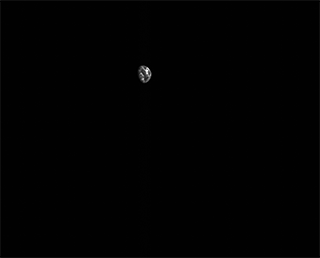
|
|---|
Dec. 14, 2015 Updated
Hayabusa2: Successful Earth swing-by and heading to Ryugu
|
JAXA confirmed that the Asteroid Explorer “Hayabusa2” entered its target orbit to travel to an asteroid Ryugu after the Earth-swing-by on Dec. 3.
|

|
|---|
Dec. 3, 2015 Updated
Hayabusa2 Earth Swing-by
|
JAXA performed an Earth swing-by operation of the "Hayabusa2" on the night of Dec 3 (Thu.), 2015 (Japan Standard Time). The "Hayabusa2 flew closest to the Earth at 7:08 p.m. (JST) and passed over the Pacific Ocean around the Hawaii islands at an altitude of about 3,090 km.
|
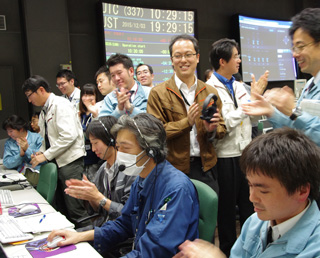
|
|---|
Nov. 27, 2015 Updated
Hayabusa2 took images of the moon and Earth
|
The Hayabusa2, which is flying closer to the Earth for its
scheduled swing-by, photographed the moon and the Earth simultaneously
using its onboard Optical Navigation Camera-Telephoto (ONC-T) at 12:46
p.m. on November 26, 2015 (Japan Standard Time). |
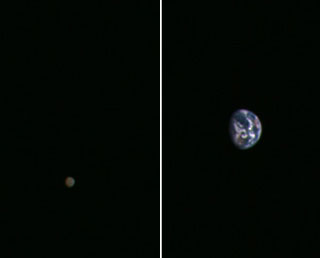
|
|---|
Nov. 2, 2015 Updated
Hayabusa2 set for Earth swing-by! Your support messages welcomed.
|
The Asteroid Explorer “Hayabusa2” will fly near the Earth to perform an Earth swing-by utilizing the Earth’s gravity on Dec. 3 (Thur.) for its orbit control.
|

|
|---|
Oct. 5, 2015 Updated
“Ryugu” was selected as name of Hayabusa2 target asteroid
|
Asteroid 1999 JU3, a target of the Asteroid Explorer “Hayabusa2,”
was named “Ryugu”. |
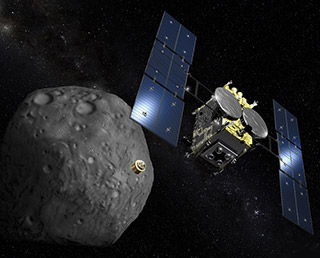
|
|---|
Sep. 2, 2015 Updated
Hayabusa2 additional ion engine operation for Earth swing-by
|
On Sept. 1 (Tue.) and 2 (Wed.), the ion engine of the Hayabusa2 was additionally operated in order to increase the orbit control accuracy for the Earth swing-by.
|
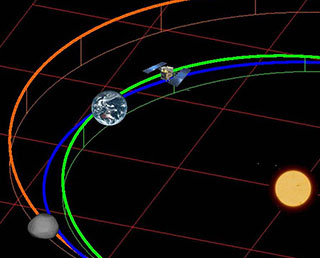
|
|---|
Jul. 22, 2015 Updated
Naming Proposal Campaign: Become a godparent of asteroid "1999 JU3", destination of Hayabusa2!
|
JAXA is holding a naming proposal campaign to christen the asteroid “1999 JU3",which the Hayabusa2 is scheduled to visit in June or July 2018. Why don’t you try to become a godparent of the asteroid? August 31, 2015 at 11:59 p.m. (Japan Standard Time). (Extended from 10:00) |
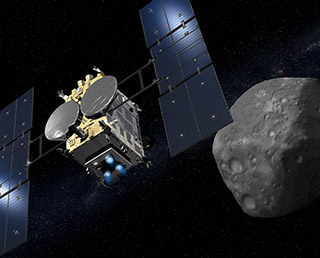
|
|---|
Jun. 8, 2015 Updated
Hayabusa2 second ion engine continuous operation completed
|
The Hayabusa2 has been continuously operating its ion engine for the
second time since June 2, and successfully completed its operations at
0:25 a.m. on June 7 (Japan Standard Time.) The second continuous
operation lasted for 102 hours as scheduled. |
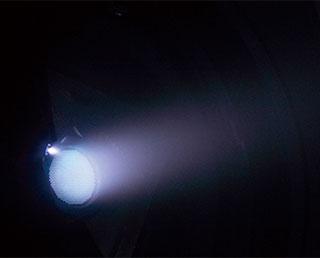
|
|---|
Apr. 10, 2015 Updated
Baton pass to new Hayabusa2 project manager
|
The Hayabusa2 is stably flying in space. The new fiscal year has just started in Japan, and JAXA is taking a new step as we became a National Research and Development Agency from the previous independent administrative agency. The Hayabusa2 project is also taking a fresh step with a new team, including handing the baton over to a new project manager. All members of the project are engaged in the mission with a fresh mindset. Message from New Project Manager Yuichi TsudaThe Hayabusa2 is stably flying since its launch and smoothly continuing it interplanetary cruising. I can, therefore, take over the mission at the best condition from my predecessor, former Project Manager Hitoshi Kuninaka, who led the development of the project. With many operation experts joining the new team, we would like to successfully send the Hayabusa2 to the asteroid 1999JU3, and have it come home safely. Message from Former Project Manager Hitoshi KuninakaAs the development phase is over, Hayabusa2’s deep space exploration has started. Photo: left: New Project Manager Yuichi Tsuda, right: Former Project Manager Hitoshi Kuninaka |
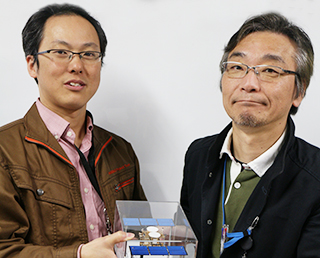
|
|---|
Mar. 5, 2015 Updated
Hayabusa2 initial functional confirmation completed and moved to cruising phase to asteroid
|
The Asteroid Explorer “Hayabusa2,” launched on Dec. 3, 2014, completed its initial functional confirmation period of about three months. The
explorer was moving to the cruising phase on March 3 while heading to the asteroid “1999 JU3.” |
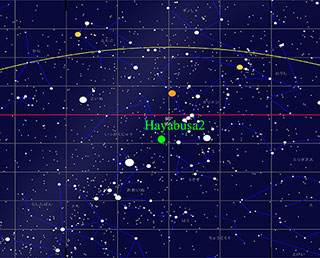
|
|---|
Feb. 3, 2015 Updated
Hayabusa2 in great shape – Initial functional confirmation going smoothly
|
The Hayabusa2, launched on Dec. 3, 2014 (JST), is now undergoing the
initial functional confirmation. Basic operations and performance of
onboard instruments and ground systems have been tested one by one as of
the end of January.
The explorer is currently in good shape.
|
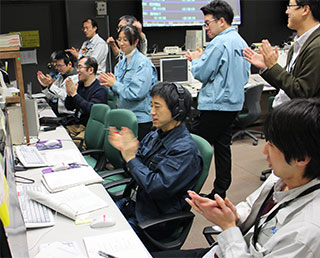
|
|---|
Dec. 5, 2014 Updated
Hayabusa2 flying smoothly!
|
JAXA confirmed the completion of a sequence of the important operations
for the "Hayabusa2" mission. With this confirmation, the critical
operation phase* of the Hayabusa2 was completed. |

|
|---|
Dec. 3, 2014 Updated
"Hayabusa2" successfully launched!
|
H-IIA F26 with the Asteroid Explorer "Hayabusa2" onboard launched at 1:22:04 p.m. on Dec 3, 2014 (JST) from the Tanegashima Space Center.
|
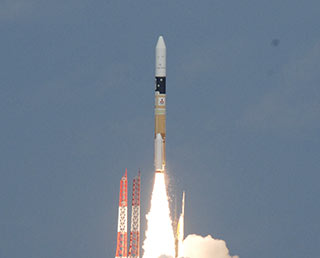
|
|---|
Nov. 30, 2014 Updated
"Hayabusa2" Launch rescheduled to 1:22:04 p.m. on December 3 (Mon.) 2014
|
Mitsubishi Heavy Industries, Ltd. and JAXA have decided to postpone the
launch of "Hayabusa2" and piggyback payloads by the H-IIA F26 to 1:22:04
p.m. on Dec 3 (Wed. JST).
|
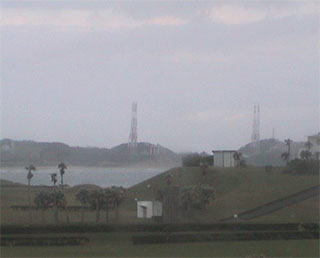
|
|---|
Nov. 29, 2014 Updated
"Hayabusa2" Launch rescheduled to 1:22:43 p.m. on December 1 (Mon.) 2014
|
The launch of the Asteroid Explorer "Hayabusa2" and three micro
piggyback payloads by the H-IIA Launch Vehicle No. 26 was rescheduled
at 1:22:43 p.m. on December 1 (Mon. Japan Standard Time, JST) after
carefully studying the weather conditions.
|
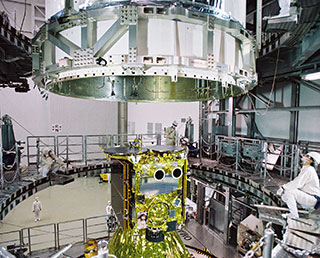
|
|---|
Nov. 28, 2014 Updated
Hayabusa2 launch postponement
|
H-IIA Launch Vehicle No.26 with the Asteroid Explorer "Hayabusa2"
onboard has been rescheduled as clouds including a freezing layer that
exceeds the restrictions for suitable weather are forecast to be
generated at around the scheduled launch time on November 30 (Sun.),
2014 (Japan Standard Time.) |

|
|---|
Nov. 27, 2014 Updated
New movie "Ready to Face New Challenges -Hayabusa2- "
|
The new video clip titled "Ready to Face New Challenges -Hayabusa2- " was uploaded to the YouTube. |
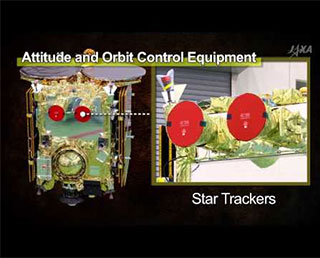
|
|---|
Nov. 4, 2014 Updated
“Hayabusa2" Launch Live Broadcast (by H-IIA F26)
|
JAXA will broadcast a live report of the Asteroid Explorer Hayabusa2’s launch by the H-IIA Launch Vehicle No.26 (H-IIA F26) from the Tanegashima Space Center. The report will cover launch events from the liftoff to the payload separation from the launch vehicle. Program summaryThe broadcast program consists of two parts. The first half mainly focuses on launch events prior to and after liftoff. Then the latter half covers events before and after the Hayabusa2’s separation from the launch vehicle. *Please be aware that the time schedule of the program is subject to change due to progress of the launch operations. Program contentsPart I
*The scheduled launch time is 1:24 p.m.
Part II
* Images of piggyback payloads’ separation will NOT be broadcast. Internet live broadcastJAXA will distribute our live report through the following Internet channels. * The copyright of the live broadcast belongs to JAXA. |

|
|---|
Sep. 30, 2014 Updated
New voyager to travel deep into space! Hayabusa2 to be launched on Nov. 30
|
The launch date and time for the H-IIA Launch Vehicle No. 26 (H-IIA F26)
with the Asteroid Explorer "Hayabusa2" onboard was decided to be at 1:24:48 p.m. on November 30 (Sunday), 2014 (Japan Standard Time)*. |
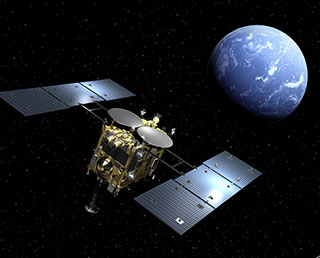
|
|---|
Sep. 5, 2014 Updated
Hayabusa2 revealed to the media
|
The Asteroid Explorer “Hayabusa2” was shown to the media at Sagamihara Campus on August 31, 2014. "I am bracing for the new voyage of the Hayabusa2." said Project Manager Kuninaka. |

|
|---|
Nov. 20, 2013 Updated
Hayabusa2 Small Carry-on Impactor undergoes test
|
Hayabusa2’s Small Carry-on Impactor (SCI) underwent a test in October, 2013. Hayabusa2 SCI test [JAXA Digital Archives] |
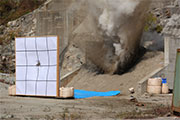
|
|---|
Jul. 17, 2013 Updated
Campaign extended till August 9 (Fri.)!
- Let's attach your name and message to Hayabusa2 -
|
JAXA has been conducting a campaign to attach names and messages of Hayabusa2 mission supporters from all over the world to the space probe! We would love to share this superb moment and feeling of achievement with you through this campaign. New deadline:
|
 |
|---|
Jun. 14, 2013 Updated
Hayabusa2 completes first integration test
|
All processes of the Hayabusa2's first integration test since January this year were completed on June 7. The test aimed at installing all onboard devices onto the satellite structure and confirming interfaces among them. During the mass property measurement, the last process of the integration test, the "Hayabusa2" exposed its full shape for the first time with all devices for the test installed. |
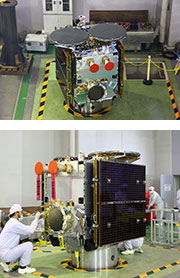 |
|---|
Mar. 29, 2013 Updated
Hayabusa2 can carry your names and messages to space
|
JAXA is holding a campaign to record your names, messages and illustrations onboard the asteroid probe Hayabusa2. |
 |
|---|
Dec. 27, 2012 Updated
Hayabusa2 revealed before the first integration test
|
On Dec. 26, the Hayabusa2 was revealed at the Sagamihara Campus. As its design was completed this spring, the Hayabusa2 will soon undergo the first integration test to confirm the interfaces among onboard devices as well as between the devices and the explorer’s bus after assembling them onto the bus. Also, the flight models of the Hayabusa2’s main body and solar array paddles have already been manufactured, thus those models will be verified through a vibration test. In addition, the exposed environment for the onboard devices will also be measured. JAXA is developing the Hayabusa2 to be ready for its launch in FY2014. |
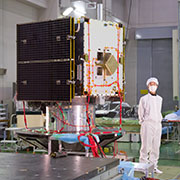 |
|---|